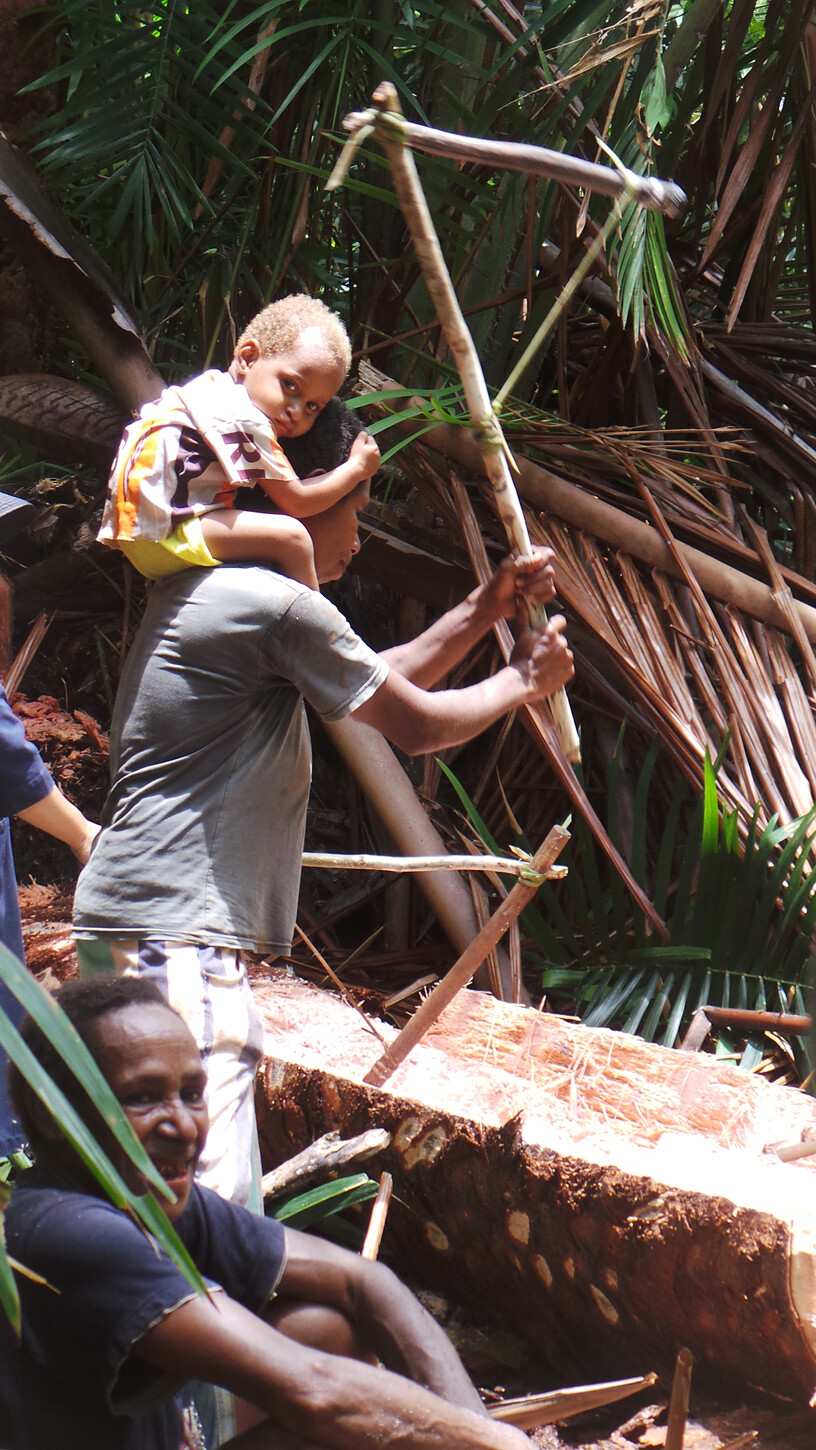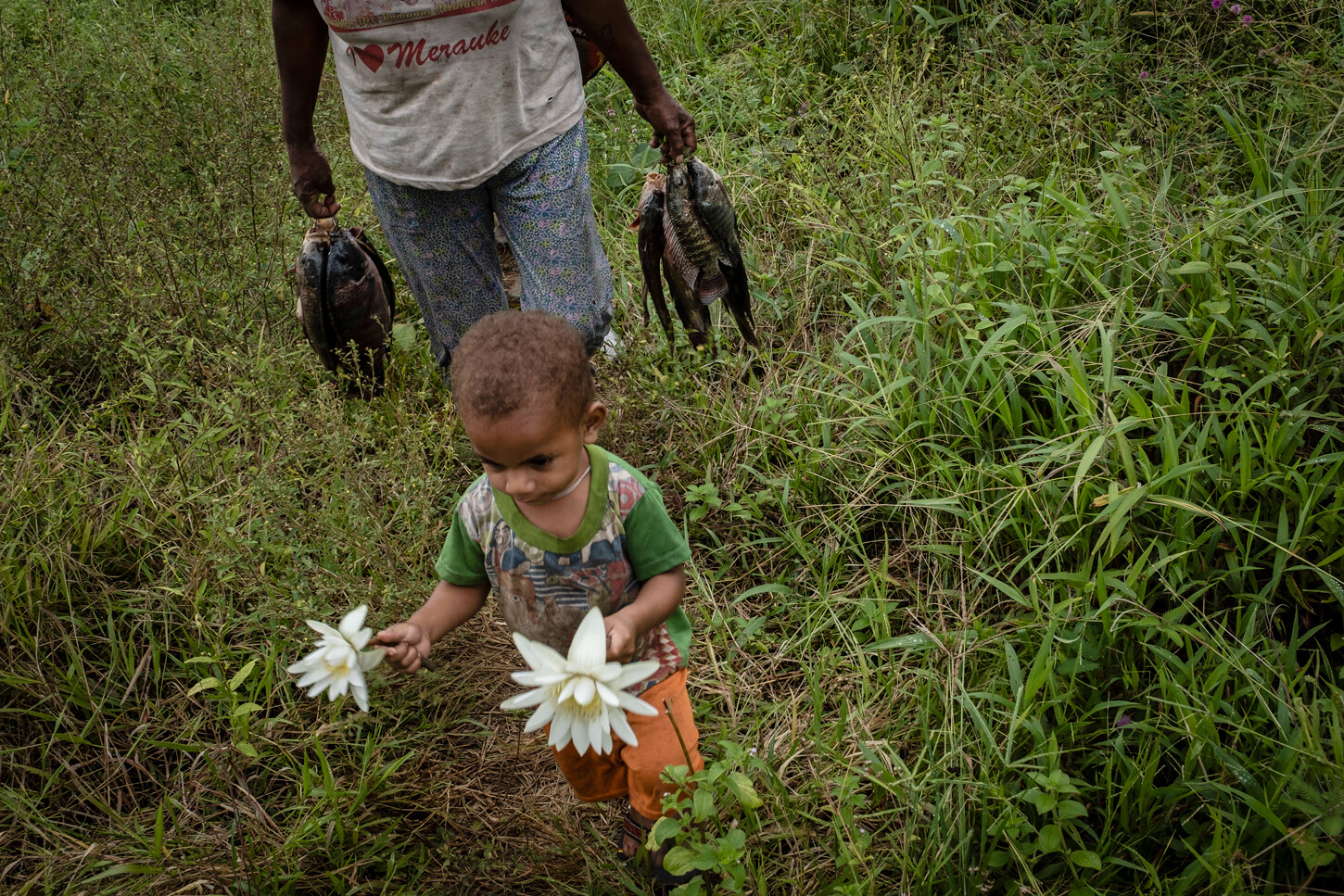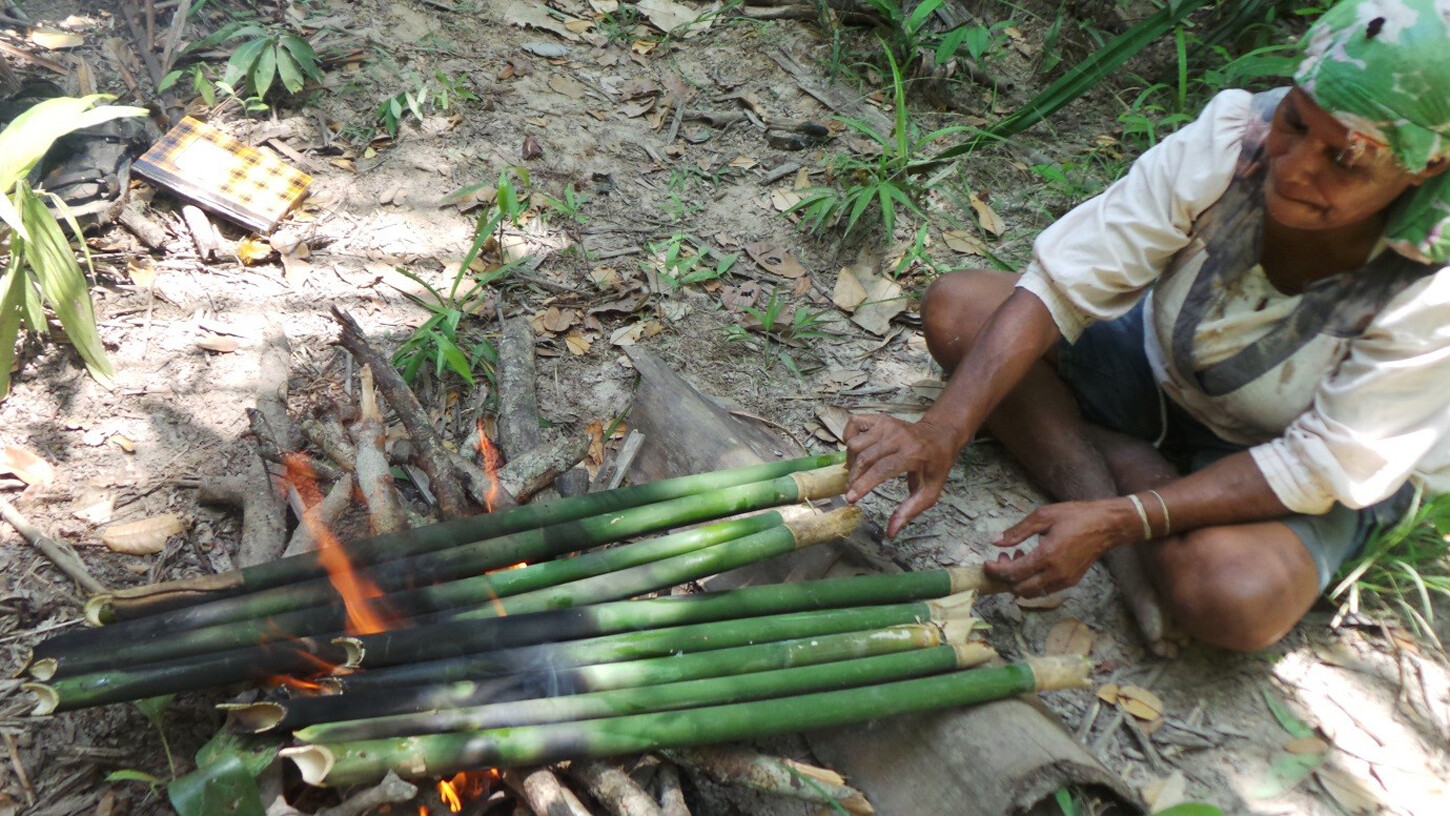Crouched ankle-deep in the mud, Marcella, a Marind woman in her late thirties from the Mirav village in rural West Papua, was teaching me how to cook sago.1 With her callused yet nimble hands, she patted the freshly leached sago starch into round, even-sized clumps, and slid them into chopped bamboo stalks, alternating sago with shredded coconut flesh, destalked papaya leaves, slivers of possum meat, and plump, writhing sago grubs. Then she carefully placed the bamboos atop a small fire of dried juniper twigs and sago fronds to steam. Her three-year-old son, Fransiskus, sat beside us, giggling. He was entertained by the sight of red ants scrambling madly around the fire, competing over stray crumbs of sago pith and coconut flesh. The air was alive with the sounds of birds and wind and river. Villagers were pounding sago and singing nearby. Children laughed and splashed in the muddy waters of the grove. Eventually, the bamboo stalks crackled and split under the heat. The sago was ready to eat.
Marcella let out a sharp hand-whistle. One by one, her companions slowly made their way to the fire—some bearing bows, arrows, machetes, knives, others fruit, betel nuts, and tubers. She distributed the bamboo stalks, pulling the charred strands apart to release the steaming contents. She took a bite, chewed it, then spit it out and placed it into her daughter’s gaping mouth. Her companions proceeded to do the same for each other—for their wives, uncles, nephews, and grandmothers. The first bite, Marcella told me, is about sharing skin and wetness. She would not eat just yet. Preparing the sago and watching her friends and family eat it had already made her feel sated. Her sweat had mingled with the sago. Now, it mingled with the bodies of her kin. This, she said, was how people shared skin and wetness with food, and then with one another.
As people ate, they began to talk and sing—about their mothers, the forest, their plant and nonhuman animal siblings, and the ancestral spirits inhabiting the grove. Singing and storying, they told me, enhances the flavors of foods consumed. It reminds people how these foods came into being, and why they always taste so much better when eaten in the forest, rather than in the village, city, or on the plantation. Singing and storying also remind people that by eating well, they too can become good food for others. Their blood, grease, sweat, tears, and flesh, nourished by plants and animals today, will live on in the bodies of organisms that consume them in the future. “In the forest,” Marcella explained, “we eat and we are eaten. We feed the forest and it feeds us. We are all food for each other.” A shrill shriek reverberated in the grove. Marcella’s son had just noticed a black leech hanging off his calf, already plump from the blood it had sucked. His mother’s resounding laugh reverberated through the forest. The multispecies feeding had begun.
The Nourishing Forest
Foraging expeditions, such as the one described above, constitute a central part of everyday life among Indigenous Marind communities in rural West Papua, among whom I have been conducting ethnographic fieldwork since 2011.2 Marind people rely primarily on native forests, swamps, and groves for their daily subsistence, which they procure through hunting, fishing, and gathering. Sago groves provide them with their staple starch food, sago flour, which is manually extracted from the felled boles of sago palms prior to flowering. Carbohydrates are supplemented with tubers and roots (mainly taro and yam), and proteins are obtained from fish and game such as deer, lorises, cassowaries, tree kangaroos, crocodiles, and pigs. Fruit including rambutans, papayas, bananas, and golden apples are also gathered in the forest, alongside roots, barks, and saps that serve to make medicinal brews. These and other foods are procured during collective expeditions that take place approximately every three months, lasting between a week and two months. Participants in the foraging expeditions I joined in the field ranged from eight years old to over thirty and included nuclear family members as well as those from extended families and clans. Children were also often brought along, as foraging trips were deemed central to their enculturation into Marind society.


Spending time with children in the forest constitutes a central part of their enculturation into local foodways. Photograph: Sophie Chao.
Forest foodways are widely associated by Marind with the condition of satiety, or kekenyangan in Indonesian. This satiety, my companions explained, stems from the vitality of the living organisms from whom forest foods are derived. Plants and animals, which Marind call “grandparents” (amai) or “siblings” (namek), share kinship through common descent with different Marind clans (boan) from ancestral creator spirits (dema).3 Also included within this more-than-human kinship system are various abiotic elements and forces—the sun, rivers, soil, rain, lightning, and dew—that, together with organismic life-forms, animate and sustain the sentient ecology of the forest.
Procuring, preparing, and consuming forest foods involves an array of ritual codes that commemorate and celebrate Marinds’ ancestral interspecies kinships. These include the incantation of spells during hunting, the ritualized handling of foods when gathered and cooked, and the recitation of songs when food is distributed and consumed. Food restrictions, too, are often explained by Marind people as expressions of respect towards plants and animals, encompassing prohibitions on hunting juvenile or gestating animals, capturing animals during the mating season, and gathering plants at the early stages of maturation. Abiding by these restrictions, Marind people attune and respond to the meaningful beings and doings of the forest, and simultaneously make respectful use of forest resources without leading to their depletion.
Knowledge (ilmu) and freedom (kebebasan) further enhance the satiation that Marind people associate with forest foods. Ilmu encompasses the varying array of origin stories, ecosystemic relations, and functional uses of plants and animals created by dema (ancestral creator spirits) in time immemorial. This vast body of knowledge, instilled into children as soon as they are able to walk and speak, includes the diverse organisms, habitats, climates, and seasons that produce the forest as a composite, nourishing, and temporally patterned environment. It entails a meticulous apprenticeship concerning which forest trails to follow or avoid, how these decisions vary depending on age, gender, and clan affiliation, and what meaningful signs or signals to consider along the way—for examples, the color and level of the river, the relative brightness or cloudiness of the sky, or the voice of a kindred bird alternately inviting human presence or cautioning against imminent danger. Transmitted from one generation to the next in the form of stories, songs, and skills, knowledge and freedom imbue forest foods with memories that are at once bodily and affective, individual and collective, and human and more-than-human.
Marind affirm that forest foods are most satiating when eaten in the forest itself. Full-bodied auditory, olfactory, and kinesthetic immersion in—and acutre observation of—this more-than-human environment enhances the gustatory, nourishing attributes of foods consumed. In the forest, for instance, Marind pay close attention to the rippling of meandering rivers, the gentle swaying of sago fronds, and the fleeting movements of insects and birds. They notice the patterned bark and foliage of nearby vegetation, and the footprints left by itinerant packs of boars and cassowaries. As they rasped and pounded sago, my companions would breathe in the rich scent of burning juniper twigs, petrichor, and damar resins. Between activities, they ran their fingers along the pubescent leaves of shrubs and bushes, and deep into the rotting sago stumps where plump sago grubs and larvae incubate. Eating, working, and feeling blended here is a form of more-than-human synesthesia. Taste and touch meld with sounds, smells, and sights.
Skin and Wetness
As Marcella imparted during our meal of sago in the grove, forest foodways are satiating because they require and enable the sharing of skin (igid) and wetness (dubadub). Central to Marind conceptualizations of the body, skin and wetness express the state of health of the individual and their social and cosmological relations. Skin refers to the exterior and visible surface of the body. It includes the physical skin of human beings, but also many other kinds of skin: the bark of trees, the coats of mammals, the laminae of leaves, the carapace of beetles, the cuticle of larvae, the topographic relief of the land, and the sleek or rippled surface of rivers and streams. Skin’s counterpart, wetness, refers to the various fluids that animate human and other-than-human bodies. Human and animal wetness takes many forms: blood, grease, muscle, sweat, saliva, and tears. It also includes sexual, maternal, and post-digestive substances such as breast milk, vaginal excretions, semen, urine, and feces. Reptile and amphibian wetness manifests in the mucilaginous integument of frogs, toads, newts, and salamanders, and in the gluey scutes and scales of snakes, lizards, and crocodiles. In vegetal organisms, wetness is found in resin, sap, pith, nectar, and in the water-carrying xylem of roots, stems, and shoots. Rivers, mangroves, swamps, mudflats, and clouds, too, are imbued with dispersed, life-sustaining wetness that supports the landscape’s terrestrial, subterrestrial, aquatic, and aerial milieus.
Each of these valued bodily attributes testifies to the organism’s ability to sustain life-generating symbiotic relations with other organisms in the forest, as both feeder and fed. Each in turn gives rise to the aesthetic, gustatory, and nourishing qualities of plants and animals as food for humans. For instance, the meat of cassowaries—that grow in the forest, drink from its rivers, and consume its berries, nuts, and snails—is chewy, salty, and intricately patterned with blood-rich capillaries. The flesh of fish nourished by juicy algae, shrimps, and worms is compact and firm to the touch, but melts exquisitely in the mouth. Similarly, sago starch is most dense and moist when obtained from palms that flourish in the abundant wetness of mangroves and swamps.
Forest foods in turn beautify and replenish the skin and wetness of Marind by imparting the life-sustaining flesh and fluids of the kindred plants and animals from whom they derive. These interspecies transfers of vitality begin long before food is ingested. For instance, as they journey across the landscape on foot during hunting, fishing, and foraging expeditions, people imbibe the moisture of the soil beneath their feet, the dew hanging in the morning air, and the droplets of rain falling from overhead. Wetness is also produced and passed on as Marind participate in food procurement and preparation activities in the grove: when they fell sago palms, rasp their boles, leach their pitch, and cook their starch. Skin, meanwhile, is strengthened through tactical engagements with the forest environment: running palms along the meandering trails left by insects along the ribbed bark of trees, caressing the fur and feathers of captured birds and possums, or digging fingers deep into the fertile muds of the grove. Matter and meaning crystallize in the forest as a multispecies contact zone, inscribed in and deciphered through the storied textures of the landscape and its nourishing beings.


A Marind father and his son return from a fishing expedition at the Bian River. Photograph: Vembri Waluyas.
Becoming Good Food for Others
Indigenous Marind foodways entail a cultivated praxis of wonder that is inextricably intertwined with the forest—a realm animated by myriad, more-than-human alterities in perpetual movement and flux, shaping Marinds’ own sense of eco-relational being, becoming, and belonging. But human satiation is only one part of the story. Just as important as the nourishment Marind obtain from the forest is the nourishment that Marind themselves provide for their other-than-human kin. Being Marind, in Marcella’s words, means becoming “good food for others” (jadi makanan enak buat lain). This entails participating in reciprocal chains of eating and being eaten within a multispecies spectrum whose collective well-being depends upon the willingness and ability of every single organism within it to shift across multiple and interlinked subjectivities—as feeder, fed, and food.
Transfers of bodily fluids are one way in which Marind become good food for others. For instance, the sweat of community members as people walk the forest sustains the growth of vegetation when it meets branches, leaves, and twigs. Villagers enhance this transfer of wetness by intentionally rubbing their hands, forearms, and calves against the trunks, shoots, and adventitious roots they encounter along the way. Sweat infiltrates the soil as people labor in the grove, nourishing a mixed community of insects and gastropods, including centipedes, ants, snails, and grubs, and infiltrating the root systems of nearby shrubs and grasses. Human blood becomes fodder for hematophagous critters such as the leech that surreptitiously crept up young Fransiskus’s leg during our visit to the grove, and the mosquitos that swarm the forest during the monsoon season. When breastfeeding their infants, women also feed the forest by smearing droplets of colostrum—the thick, golden fluid produced in the first few days after childbirth—on the trunks and shoots of nearby sago palms to encourage vegetative reproduction in the form of suckers and stolons.
Other, more indirect transfers of fluid are encouraged through the ritualized etiquette that accompanies food procurement, preparation, consumption, and disposal in the forest. Hunters, for instance, impart their sweat upon the small portions of fruit, nuts, and sago flour that they leave at the sites where they capture and kill game. These are given in exchange for the life of the animal taken and as a sign of respect towards its kin. Similarly, when people encounter juvenile or gestating animals and birds in the forest, tactically mediated food offerings are left near the animals’ nests or burrows. When food is being cooked, villagers scatter sago flour around the fire for maleo fowl and pigs to consume. A share equivalent to an adult male’s intake, and often including a portion of pre-masticated food, is always saved for forest animals, and is usually placed atop a mound of soil or wrapped in layered banana leaves. Formulaic songs and incantations are performed to entice animals to consume this food and to find nourishment in the human sweat and saliva that have mingled within them.
Beyond their own life, Marind continue to become good food for their other-than-human kin long after their death. While burial in the village cemetery is now widely practiced, many of my companions affirmed that they wished to be interred in the forest, so that their bodies would become “useful” (berguna) to others. In the traditional mode of burial, corpses are wrapped in dried sago fronds and placed a meter or so underground, then covered with earth, upon which a young nypa or other palm shoot is planted. As the body decomposes, human flesh and fluids seep into the ground where they are ingested or otherwise absorbed by subterranean earthworms, beetles, and millipedes. Larger mammals, reptiles, and birds that prey upon these organisms take in the skin and wetness of the deceased, passing it on to their own progenies through reproduction and eventually returning it to the forest when they die or are consumed. The flourishing of the plant atop the burial site is also enhanced by the community of critters that feed off the flesh and fluids of human bodies, and to the nutrient-enriched soil that this decomposition produces.
Eating Well in a More-Than-Human World
For Marind people, eating well during one’s own lifetime is significant not only for the health and well-being of the consumer, but also because it enables the consumer to become good food for others. This care of the self is also a care for the many human and other-than-human beings across space and time. The skin, wetness, and vitality of their bodies constantly disperse, cycle, and recycle within the feeding flows of forests as nourishing terrains. Just as the collective care of feeding other humans is recognized in the anatomic form of bodily skin and wetness, so too the collective care of nourishing the environment is concretized in the perceived health, diversity, and fertility of the landscape itself. The state of the body affects that of the environment and vice versa.
Indigenous Marind foodways are animated by humans, animals, and plants who are bound with and against each other in reciprocal dynamics of feeding and being fed. Across these diverse relations of mutual nourishment, different foods serve different transformative purposes. Each is dependent on, and diagnostic of, the inter-agentive relations between the consumer and the consumed. As ontological and material relation, food connects human and other-than-human beings within unevenly distributed meshes of eating and being eaten.
Reckoning with these connections raises the moral question of what it means to eat well and feed well in an increasingly vulnerable more-than-human world. In this age of self-devouring growth, when intensifying capitalist extraction are undoing ecosystems at local and planetary scales, we might generatively take Marinds’ lead in asking ourselves: How do practices of consumption connect humans, in (perhaps) unwitting yet complicit ways, to seemingly remote places and communities? What powers and forces dictate what goes into which bodies, what counts as food when food means life, and who or what becomes the eater and eaten? How do cultural values and system shape not just what we eat, but what is eating us—to whose benefit, and at whose cost? And how might we counter anthropocentrism and human exceptionalism by reimagining ourselves, like Marind do, as good food for others?
*
Recipe from the Sago Grove
Ingredients:
–sago flour, freshly rasped
–sago grubs, plump and writhing
–coconut flesh, sweet and slippery
–bamboo stalks, semi-mature
–papaya leaves, slim and of the darkest of greens
–juniper leaves, bushy and dry
–banana leaves, wide and yellow
Directions:
Light a small twig fire. Rinse the bamboo stalks in fresh water, inside and out. Fill the bamboo stalks, alternating sago flour, sago grubs, coconut flesh, and papaya leaves. Press the ingredients compactly into the stalk. Right before cooking, add a few juniper leaves to the fire for fragrance. Line the bamboo stalks along the top of the flames, turning them around every few minutes for an even cook. Look up at the sky. Look around in the grove. Notice the smells. Notice the sounds. Join them with song. When the ends of the bamboo stalks start to steam and their surface becomes lightly charred, remove from the heat. Wrap the stalks in banana leaves to retain fragrance and heat. Once cool enough to handle, knock the stalks against each other firmly to break them. Pull the bamboo filaments downwards to release the content. Serve the bamboo stalks on a bed of fresh sago fronds.
Pseudonyms have been used throughout this essay for the safety of persons named.
I conducted eighteen months of ethnographic fieldwork in the villages of Mirav, Bayau, and Khalaoyam in the capacity of human rights counsellor between 2011 and 2013 and in the capacity of doctoral and postdoctoral researcher between 2015 and 2019. My fieldwork was facilitated by Indonesian and Papuan human rights NGOs and explored how deforestation and agribusiness development reconfigure the more-than-human lifeworld of Marind communities. Central to this research was a close observation of and participation in Marinds’ everyday and ritual food procurement, preparation, and consumption practices across the spaces of village and forest.
All the terms in this sentence are in Marind.
Subject
This essay is derived and adapted from the monograph Land of Famished Beings: An Indigenous Theory of Hunger from the West Papuan Plantation Frontier, currently under review with HAU Books.










